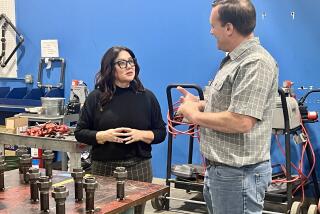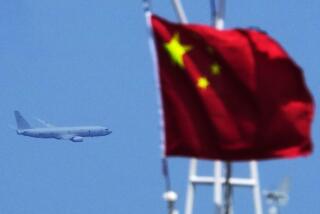L.A. delegation seeks brotherhood in China
BEIJING — The Chinese hosts didn’t know quite what to do. They had a bus full of foreigners -- Americans, at that -- chanting “Si, se puede!” and clapping their hands in rhythm.
Was this the new world of globalism?
It was, precisely.
The boisterous Americans were representatives of the Los Angeles County Federation of Labor, the second high-level labor delegation from the United States to visit Beijing in the last month. Their chanting (“Yes, we can!” in Spanish) on Tuesday was simply a way of thanking a somewhat bewildered Chinese translator and driver.
Their presence here was the latest indication that a decades-old freeze between trade unions in the two countries had begun to thaw. At least some American labor leaders seem to be road-testing a new policy: “If you can’t beat ‘em, join ‘em.”
“This isn’t just the theory of ‘Workers of the world unite,’ ” said Maria Elena Durazo, head of the L.A. federation. “This is about very real needs that workers in both countries have.”
The visit comes at a propitious time for China’s state-sanctioned labor organization, the All-China Federation of Trade Unions. On Friday, the Standing Committee of the National People’s Congress passed a far-reaching labor law reform package that gave Chinese workers -- on paper, at least -- rights that in some respects exceeded those guaranteed American workers.
The Chinese have also in recent months signed labor contracts with two giant employers that have long resisted American union drives: Wal-Mart Stores Inc. and McDonald’s Corp.
“We’re just really dumbfounded about how they were able to organize Wal-Mart here,” said Ray Familathe, director of international affairs for the International Longshore and Warehouse Union (ILWU) and one of the 10 members of the California delegation.
American labor has long shunned its Chinese counterparts for being pawns of the communist government -- a description that is not entirely inaccurate. But with China becoming an ever more powerful player in the global economy, and the Chinese union flexing its muscle against multinational corporations, American labor leaders have grown intrigued.
Last month, Teamsters President James P. Hoffa led a delegation from the Change to Win labor coalition to Beijing for meetings with Chinese labor leaders. By the end of the trip, the American delegates were calling for closer ties with the Chinese union.
And the Wall Street Journal recently reported that John Sweeney, head of the AFL-CIO, planned to visit China in his role as president of the Trade Union Advisory Council of the Organization for Economic Cooperation and Development, even though the AFL-CIO itself retained a Cold War-era policy against ties with the Chinese union.
“The Cold War is over,” said Dave Arian, past international president of the ILWU and one of the members of the Los Angeles delegation. “The economy that they have in this country is essentially the same as we have in the United States.”
There would be no shortage of people prepared to argue that point, given the very different nature of the government’s role in the Chinese economy -- more involved as the owner of many enterprises, less involved in regulatory enforcement.
The Chinese people were shocked in recent weeks to learn that hundreds of workers, many of them children, were forced to work as slaves in brick kilns in northern China while local authorities apparently looked the other way.
But Arian’s larger point, repeated by other union leaders on the trip, was that what happens in China affects the United States, and the management of multinational corporations is more than a decade ahead of labor in recognizing that.
“Capital sees no boundaries,” Durazo said. “Why should labor see a boundary?”
The L.A. contingent was heading to Shanghai today for the primary purpose of its trip -- meetings with the Shanghai Trade Union Council, with which the American group is establishing a formal, sister city partnership, the first of its kind between unions in the two countries.
Shanghai and Los Angeles have a strong labor connection because of their ports, which often handle the same cargo on their respective ends of its transpacific voyage. Delegates from the longshore workers union said they hoped to learn how the Chinese performed the same jobs that American workers did, how well they were trained, and whether they had safety or other issues in common.
“Our job,” said Arian, “is to lay the groundwork for worker-to-worker relationships in all the major ports.”
The L.A. labor leaders got a taste of challenges facing them, however, in a tour of a heavy machinery factory outside Beijing on Tuesday. Met by a delegation from the factory, they were led to a meeting room, where an executive from the company, Beiren, explained the union’s role at great length while the factory’s union officials sat flanking him and listened.
He stressed the union’s role in training workers “to improve the efficiency of their work,” to “contribute to the economic growth of the company” and to help in “cultivating a corporate culture” through recreation programs, such as a photography club and a calligraphy club. Only when a Chinese union leader finally spoke was there any mention of the union’s role in wage negotiations, and barely then.
That approach is in keeping with the Chinese government’s push to create a “harmonious society.” But it was clear that the Chinese were, both literally and figuratively, speaking another language from the Americans.
“We come here and they’re talking about harmony,” said Durazo. “Harmony? With someone who’s just thinking about maximum profit? We just can’t think that way.”
--
More to Read
Inside the business of entertainment
The Wide Shot brings you news, analysis and insights on everything from streaming wars to production — and what it all means for the future.
You may occasionally receive promotional content from the Los Angeles Times.










